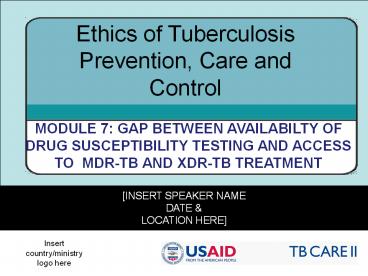[insert Speaker Name - PowerPoint PPT Presentation
1 / 12
Title:
[insert Speaker Name
Description:
[insert Speaker Name. Date & Location here] Ethics of Tuberculosis Prevention, Care and Control. MODULE 7: GAP BETWEEN AVAILABILTY OF DRUG SUSCEPTIBILITY TESTING AND ... – PowerPoint PPT presentation
Number of Views:76
Avg rating:3.0/5.0
Title: [insert Speaker Name
1
Ethics of Tuberculosis Prevention, Care and
Control
MODULE 7 GAP BETWEEN AVAILABILTY OF DRUG
SUSCEPTIBILITY TESTING AND ACCESS TO MDR-TB AND
XDR-TB TREATMENT
insert Speaker Name Date Location here
Insert country/ministry logo here
2
Objectives
- Upon completion of this module, you will be able
to - Discuss reasons for and challenges with gap
between diagnosis and treatment of drug-resistant
TB and need to address this gap - Explain the benefits of drug susceptibility
testing in the absence of drug-resistant TB
treatment - Demonstrate why education and counselling forms
an essential component of patient care in the
absence of drug susceptibility testing (DST) and
appropriate treatment for drug-resistant TB
3
Gap between diagnosis and treatment
- Point-of-care rapid diagnostic methods at the
outset of the diagnostic process can
revolutionise the treatment of MDR- and XDR-TB by
enabling the use of a tailored drug therapy - Countries should ensure that patients diagnosed
through these measures are provided access to the
most appropriate drugs - Scaling up and providing treatment, including
treatment for MDR-TB and XDR-TB is an essential
element of providing ethical TB care (universal
access to care)
4
Gap between diagnosis and treatment -2
- While countries are in the process of scaling up
treatment for MDR/XDR-TB, the use of drug
susceptibility testing may be appropriate - May be used as an interim measure even where
- Second- or third-line drug treatment is not
available - The only available treatment is substandard
- Patients MUST be asked to provide informed
consent for diagnostic testing in absence of
treatment - Countries, TB Programmes and providers should
focus on ensuring adequate treatment is available
for all who are diagnosed with drug-resistant TB
5
Ethical approach to scaling up MDR/XDR-TB
treatment
- 3 AQ Principles should be incorporated as
universal access to care for drug resistant is
implemented in countries is scaled up and
implemented - Availability Facilities, goods and services and
programmes are available in sufficient quantity - Accessibility Facilities, goods and services are
accessible to all (non-discrimination, physical,
economic, and information accessibility) - Acceptability Respectful of medical ethics,
culturally appropriate, respect of
confidentiality - Quality Scientifically and medically appropriate
and of good quality skilled medical personnel,
scientifically approved and unexpired drugs and
hospital equipment, safe water, sanitation
6
Benefits of offering drug susceptibility testing
in absence of treatment
- Provide evidence of a high prevalence of MDR- and
XDR-TB - Ensure that individuals with M/XDR-TB are not
inappropriately treated with regular TB drugs - Guide decisions about segregating TB patients
being cared for in a closed environment - Help individuals make life plans, diminish impact
of disease on family members, and inform
important behaviour regarding infection control
7
What happens in your setting?
PLENARY
- Is there access to drug susceptibility testing
for patients? - If no, why not, what can be done to change this?
- Is treatment available for MDR-/XDR-TB?
- If no, Why not and what can be done to change
this (especially in cases where DST IS
available?) - If yes, how do you manage and treat patients?
- If MDR-/XDR Treatment is available, is it
provided in a way that is accessible to patients?
(in light of human rights context of
non-discrimination, physical, economic, and
information accessibility) - If no, why not, what can be done to change this?
- If yes what have been the challenges in in
providing this access and how were they
addressed?
8
Making ethically appropriate treatment decisions
in absence of DST
- Ideally all patients should undergo rapid
drug-resistance testing in order to ensure
provision of appropriate treatment regimens - Approach benefits to both patients and community
- Reduces risk of further spread of TB
- Reduces development of drug-resistant TB strains
- For resource-constrained countries that cannot
meet obligation to provide drug susceptibility
testing on their own - International community should provide financial
and other support, in keeping with the ethical
principles of social justice and equity
9
Making ethically appropriate treatment decisions
in absence of DST
- For countries that are still scaling up their
capacity - Treatment decisions should be made on an
individualised basis based on - Local epidemiology
- Patient specific factors
- Decisions should ideally be made in consultative
process involving - Multiple practitioners
- Patient advocate (when available)
10
Making ethically appropriate treatment decisions
in absence of DST
- For patients
- Education and counselling should be offered this
will ensure that - Patients are fully informed
- Informed consent has been provided prior to
testing
11
Lets discuss..
CASE STUDY
A 29 year old patient, who lives in a community
where there is a high prevalence of
drug-resistant TB has just been diagnosed with
TB. She has three children, aged 7, 4 and 18
months. Her husband works in the mines and lives
in the mining hostel. He returns home once every
quarter. He has been losing weight and has not
been able to work. She last had an HIV test when
she was pregnant with her youngest child (which
was negative). Her mother-in-law and her
husbands niece, who is 16, lives with
her. Presently, there are no drug susceptibility
testing facilities available at the hospital.
- What steps would you take for the treatment, care
and support of the patient? - How would you counsel the patient?
12
(No Transcript)































